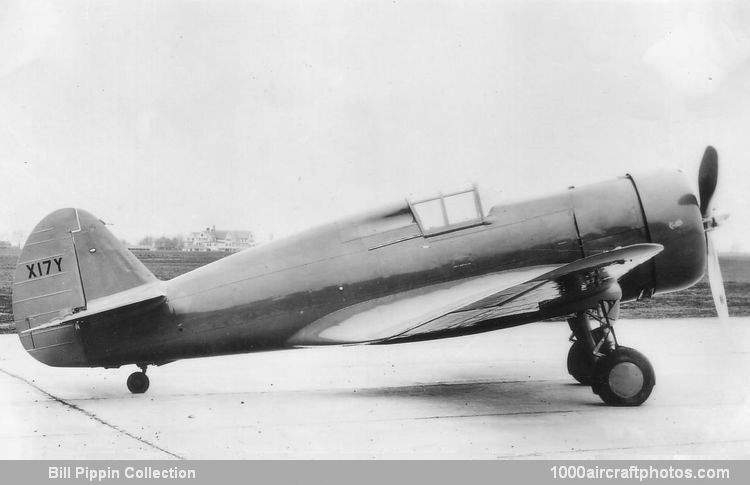02/28/2011. Remarks by Jack McKillop: "Procurement of aircraft by the USAAC in the 1930s was quite different from what is done today. In those days, the military would publish a requirements document listing the attributes of a specific type of aircraft that they wanted. Each manufacturer that wished to receive a contract had to build an aircraft at their own expense and then the Army would test each and select one winner.
In 1934, the USAAC issued a set of requirements for a single-seat monoplane fighter with speeds in the region of 300 mph (483 km/h). This new aircraft was a replacement for the Boeing P-26 (nicknamed "Peashooter"). The tests between the various competitor was originally scheduled for May 1935 but were postponed until August 1935 and then postponed again until April 1936.
The five competitors were:
Consolidated Aircraft Corporation, Buffalo, New York. They entered their PB-2A Special, this was the seventh PP-30/PB-2A two-seat pursuit aircraft modified as a single-seat pursuit. The plane crashed during the competitive tests.
Northop Corporation, Los Angeles, California. Northrop entered their Gamma 3A pursuit, preliminary tests showed that the plane was 'rather unstable and prone to spin'. It was returned to California for modifications and on July 30, 1935, it was taken on a test flight and disappeared over the Pacific off the California coast.
Chance Vought Aircraft Company, East Hartford, Connecticut. Vought purchased the rights and plans for the Northrop Gamma 3A and 43 days later, they entered their Model V-141 pursuit in the competition. The V-141 displayed poor directional control and spinning characteristics and was rejected.
Seversky Aircraft Corporation, Farmingdale, New York. This company entered their Model SEV-2XP but it was damaged en route to Wright Field and was returned to the factory. It was repaired and redesignated SEV-1XP but when Seversky changed the engine and tail surfaces, it was redesignated SEV-7.
Curtiss Airplane Division, Buffalo, New York. Work on the Curtiss Hawk 75 (Model 75) began in November 1934 and the pictured prototype, powered by a 900 hp Wright R-1670 fourteen-cylinder, two-row, air-cooled radial engine, first flew May 15, 1935.
The Model 75 was an all-metal low-wing monoplane with the control surfaces fabric covered, a retractable landing gear that rotated backward 90° and turning 90° to lay flat in the wheel wells and a cockpit canopy. The R-1670 engine was unsatisfactory and was replaced by a 700 hp Pratt & Whitney R-1535 fourteen-cylinder, two-row, air-cooled radial engine but this engine was obsolete and it was finally replaced by a 675 hp Wright R-1820F nine-cylinder, single-row, air-cooled radial engine. In this final configuration, the Model 75 was redesignated Model 75B.
The airframe/engine problems of the Model 75B were not resolved when the competition was held in April 1936 and the top speed of the aircraft was only 285 mph (459 kmh). As a result, Seversky was awarded a contract for 76 P-35s that were delivered between July 1937 and August 1938.
Since the Model 75B finished second in the competition, the USAAC gave Curtiss a consolation prize of an order for three service test Y1P-36 Hawks (serialed 37-68 to 37-70) on August 5, 1936. These aircraft were powered by the 1,050 hp Pratt & Whitney R-1830-13 fourteen-cylinder, two-row, air-cooled radial engine. (The Y1P-36s were redesignated P-36s after testing.) In July 1937, the Army gave Curtiss a contract for 210 P-36A Hawks (Curtiss Model 75L) and this was the first line pursuit aircraft in the USAAC until the P-40 was introduced.
Curtiss realized that because of the advancements in aviation in the 1930s, the service life of the P-36 with the R-1830 engine would be short. So they replaced the radial engine with an 1,150 hp Allison V-1710-11 twelve-cylinder, liquid-cooled V-engine. With this engine, the aircraft was redesignated Curtiss Model 75I and became the first US pursuit aircraft to exceed 300 mph (483 kmh).
On February 16, 1937, the USAAC purchased the Model 75I with the same c/n and USAAC serial number 37-375, and designated it XP-37. It first flew on April 20, 1937 and was delivered to the Army in June 1937. The cost of the aircraft, less government furnished equipment, was US $104,352 (US $1.58 million in 2010 dollars). The XP-37 became a ground instructional machine in August 1941 with only 152 hours on the airframe."
